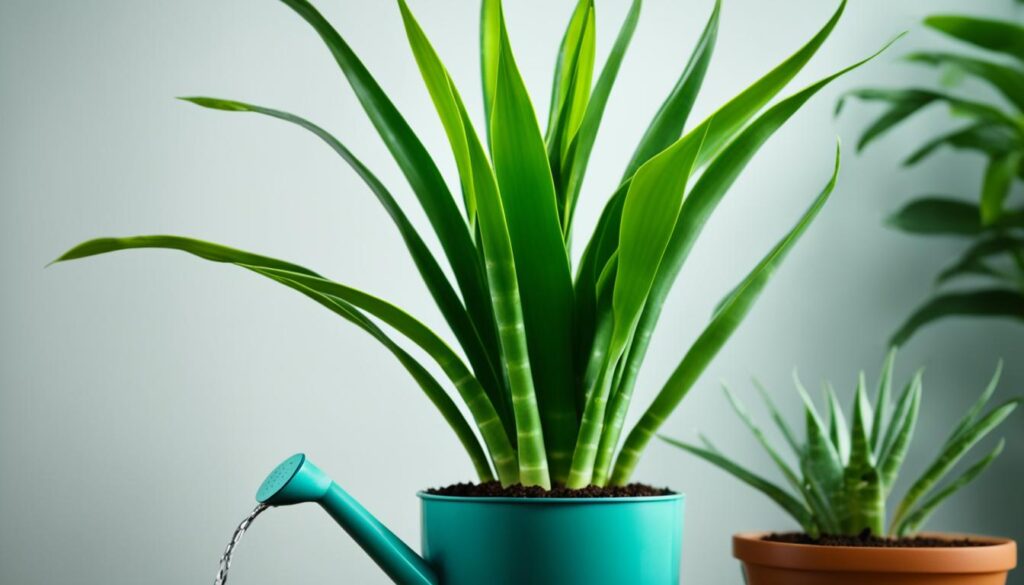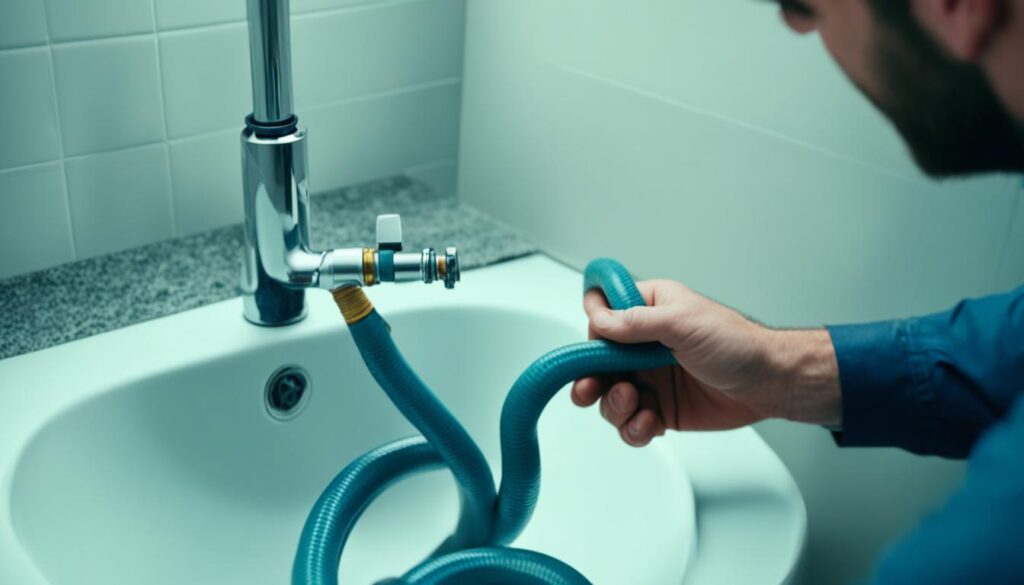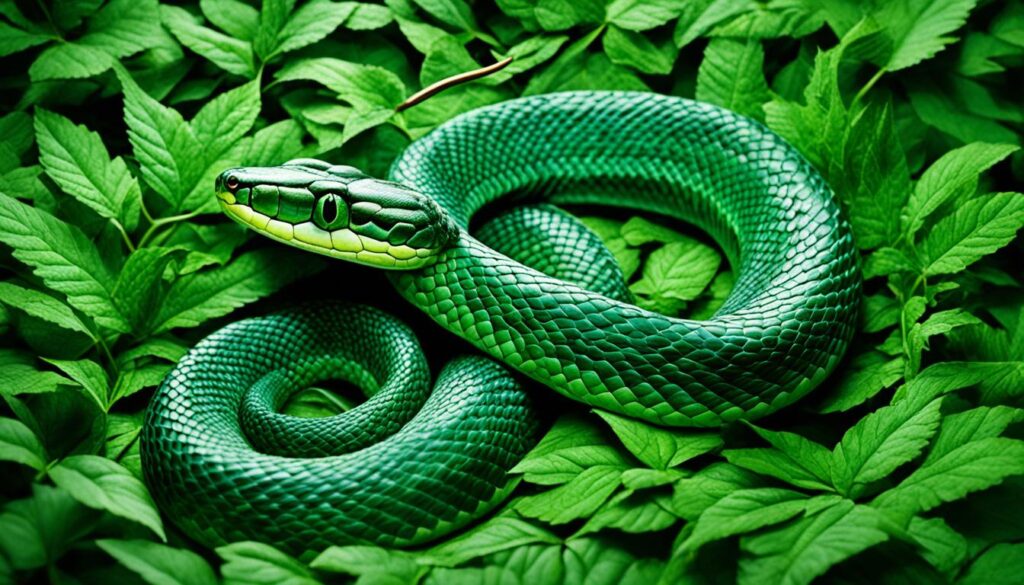Imagine this: you walk into a room filled with vibrant green foliage, and your eyes are drawn to a stunning plant with tall, sleek leaves. Its name is Sansevieria trifasciata, but you probably know it as the snake plant. Its beauty is captivating, but what’s truly remarkable is its ability to thrive with minimal care. This plant is like a resilient friend who always has your back, even when you forget to water it for weeks. But just like any friend, it still needs your occasional attention to stay healthy and happy.
So, how often should you water your snake plant? The answer lies in understanding its unique watering requirements, which are influenced by factors such as light, temperature, humidity, soil type, and potting container. By tuning in to these factors and finding the right watering schedule, you can ensure your snake plant continues to be a show-stopping centerpiece in your home.
Key Takeaways:
- Knowing how often to water snake plants is crucial for their overall health.
- Several factors, including light, temperature, humidity, soil type, and potting container, influence a snake plant’s watering schedule.
- A general rule is to water snake plants once their soil has completely dried out.
- Signs of underwatering include brown, crispy leaf tips and compacted soil.
- Overwatering can lead to yellow leaves, mushy stems, and root rot.
Factors Affecting Watering Schedule
Several factors can influence how often you should water your snake plant. The amount of light it receives, temperature, humidity levels, soil type, and the type of potting container it’s planted in all play a role in determining its water requirements.
Snake plants can grow in a variety of lighting conditions, from bright light to low light, but their watering needs will vary based on the amount of light they receive. When to water your snake plant will largely depend on its light exposure.
Temperature and humidity also impact water requirements, with warmer temperatures and higher humidity levels requiring more frequent watering. Additionally, the type of soil and potting container used can affect how often the snake plant needs to be watered.
Lighting Conditions
Snake plants can adapt to various light conditions, but the amount of light they receive affects their watering needs. In brighter locations, snake plants tend to dry out faster, so you’ll need to water them more frequently. If your snake plant is in a low-light area, it won’t require watering as often. Observe your plant and adjust the watering frequency accordingly.
Temperature and Humidity
Consider the temperature and humidity levels in your snake plant’s environment. Warmer temperatures and higher humidity increase the plant’s transpiration rate, causing it to require more water. Cooler temperatures and lower humidity lead to slower water evaporation, meaning your snake plant will need less frequent watering. Take these factors into account when deciding when to water your snake plant.
Soil Type and Potting Container
The type of soil and potting container can also affect your snake plant’s watering needs. Well-draining soil, such as cactus soil, allows excess water to escape easily, preventing waterlogged roots that can lead to root rot. If your snake plant is potted in a container without drainage holes, it’s crucial to be mindful of the watering frequency to avoid overwatering. Consider these factors when determining the optimal watering schedule for your snake plant.
Ideal Watering Schedule for Snake Plant
When it comes to watering your snake plant, understanding the ideal watering schedule is key to promoting its health and growth. As a general rule, snake plants should be watered once their soil has completely dried out. This allows the plant to take in just the right amount of moisture without risking overwatering.
The frequency of watering may vary depending on the time of year and environmental conditions. During the spring and summer months, when there is increased light and warmer temperatures, snake plants generally need more water. Aim to water your snake plant once a week, or every two to three weeks, depending on the specific conditions.
On the other hand, during the fall and winter months, when light and temperature levels are lower, snake plants require less frequent watering. Typically, watering every two to three weeks, or even less, will be sufficient to keep your snake plant healthy.
Remember that every snake plant is unique, so it’s important to monitor the moisture levels of the soil and adjust the watering schedule accordingly. Observing the plant’s foliage, soil texture, and growth patterns can provide valuable insights into its hydration needs.
Follow these watering instructions for your snake plants to ensure their optimal well-being:
- Check the soil: Before watering, use your finger or a moisture meter to check the moisture level of the soil. It should be completely dry up to a few inches deep.
- Water thoroughly: When it’s time to water, thoroughly drench the soil until water drains out of the bottom of the pot. This ensures that the plant’s roots receive adequate hydration.
- Allow proper drainage: Proper drainage is essential for snake plants to thrive. Ensure that your pot has drainage holes to prevent water from accumulating and causing root rot.
- Prevent overwatering: Overwatering can be detrimental to snake plants. Avoid watering if the soil is still damp or wet, as this can lead to root rot and other issues.
By following these watering guidelines, you can maintain a healthy balance and provide your snake plant with the optimal amount of water it needs to flourish.
Signs of Underwatering
If you notice any of the following signs in your snake plant, it may be a sign that it needs more water:
- Brown, crispy leaf tips: This is a common indication that your snake plant is not getting enough water. The tips of the leaves will turn brown and become brittle.
- Dying leaves: When a snake plant is underwatered, the leaves may start to wither and eventually die off.
- Hard, compacted soil: If the soil is dry and hard, and it’s pulling away from the edge of the pot, it means your snake plant is thirsty.
If you notice these signs, it’s important to take action to revive your underwatered snake plant. Repotting the plant and providing fresh, well-draining soil can help improve its condition. Additionally, regular waterings should be scheduled to replenish the plant’s moisture content and restore its health.
Sample Table: Signs of Underwatering
| Signs of Underwatering | Description |
|---|---|
| Brown, crispy leaf tips | Indicates insufficient moisture, causing leaf tips to become brown and brittle. |
| Dying leaves | Underwatering can lead to withering and eventual death of the leaves. |
| Hard, compacted soil | Dry and compacted soil that is pulling away from the edge of the pot. |
Observing and addressing the signs of underwatering in your snake plant is crucial for maintaining its well-being and promoting healthy growth.
Signs of Overwatering
Overwatering a snake plant can have detrimental effects on its health. It’s crucial to recognize the signs of overwatering to prevent further damage. Take note of the following indications:
- Yellow leaves: If you notice that the leaves of your snake plant are turning yellow, it may be a sign of overwatering. The excess moisture causes the leaves to become discolored and can lead to the deterioration of the plant.
- Mushy stems: Overwatering can lead to soft and mushy stems in snake plants. When the roots are constantly submerged in water, they become waterlogged, resulting in weak stems.
- Waterlogged soil: Excessive watering can cause the soil to become waterlogged. If you touch the soil and it feels excessively wet or soggy, it’s a clear sign that you are overwatering your snake plant.
- Water buildup in the pot: Another indication of overwatering is the presence of water buildup in the pot. If you notice water collecting in the bottom of the pot or excess water spilling out of the drainage holes, it’s essential to address the issue promptly.
If you observe any of these signs, it’s crucial to take immediate action. Start by unpotting the plant and carefully inspecting the roots for any signs of root rot. Overwatering can lead to root rot, a serious condition that can eventually kill the plant if left untreated. Removing any damaged or rotted roots and replanting the snake plant in well-draining soil can help revive it.
| Signs of Overwatering | Actions to Take |
|---|---|
| Yellow leaves | Check for signs of root rot, remove damaged leaves, and adjust watering frequency. |
| Mushy stems | Inspect the roots for signs of root rot, trim damaged stems, and allow the plant to dry out. |
| Waterlogged soil | Ensure proper drainage by selecting a well-draining pot and soil. Adjust watering schedule accordingly. |
| Water buildup in the pot | Improve drainage by adding a layer of stones at the bottom of the pot. Be mindful of watering amounts. |
Watering Techniques and Tips
When it comes to watering your snake plant, it’s essential to strike the right balance. Underwatering is generally better than overwatering, as snake plants are highly tolerant of drought conditions. To ensure you’re providing optimal care for your snake plant, consider the following watering techniques and tips:
Wait for Complete Drying
A good rule of thumb is to wait until the soil has completely dried out before watering your snake plant. Overwatering can lead to root rot and other issues, so it’s best to err on the side of caution. If you’re unsure whether it’s time to water, use a moisture meter to check the soil’s moisture levels.
Bottom Watering
A preferred watering technique for snake plants is bottom watering. This involves placing the pot in water and allowing it to soak through the drainage holes. By watering from the bottom, you ensure that the plant’s roots receive sufficient moisture without oversaturating the soil. This method also helps prevent water from sitting on the leaves, reducing the risk of overwatering.
Avoid Misting
While misting may seem like a convenient way to provide humidity, it’s important to avoid misting snake plant leaves. Misting can lead to overwatering and increased moisture on the leaves, which can promote the growth of fungus or pests. Instead, focus on maintaining the plant’s overall humidity through proper watering techniques.
Tap Water vs. Purified Water
You can use tap water to hydrate your snake plant, but it’s best to use purified water. Tap water often contains chlorine, which can build up in the soil and affect the plant’s health over time. Purified water, such as filtered or distilled water, reduces the risk of chlorine-related issues and helps maintain the plant’s vitality.
Growing in Water
While snake plants are typically grown in soil, they can also be grown in water alone. This hydroponic method involves placing the snake plant in a container with water, where it absorbs nutrients directly from the water. If you choose this method, it’s important to change the water regularly to prevent stagnation and maintain the plant’s health.
| Watering Techniques and Tips | Benefits |
|---|---|
| Wait for complete drying | Prevents overwatering and root rot |
| Bottom watering | Ensures proper hydration without overwatering |
| Avoid misting | Reduces the risk of overwatering and fungal growth |
| Tap water vs. purified water | Prevents chlorine buildup and maintains plant health |
| Growing in water | An alternative method for snake plant cultivation |
By following these watering techniques and tips, you can provide the best care for your snake plant and ensure its long-term health and beauty.
Choosing the Right Pot and Soil
The choice of pot and soil can significantly impact the watering needs of your snake plant. To ensure optimal care for your plant, here are some essential considerations when selecting the right pot and soil:
1. Drainage is Key
When choosing a pot for your snake plant, opt for one with proper drainage holes. This allows excess water to flow out, preventing waterlogged soil and potential root rot. A pot with drainage holes ensures that water does not accumulate at the bottom, promoting healthier growth for your snake plant.
2. Terracotta Pots for Faster Drying
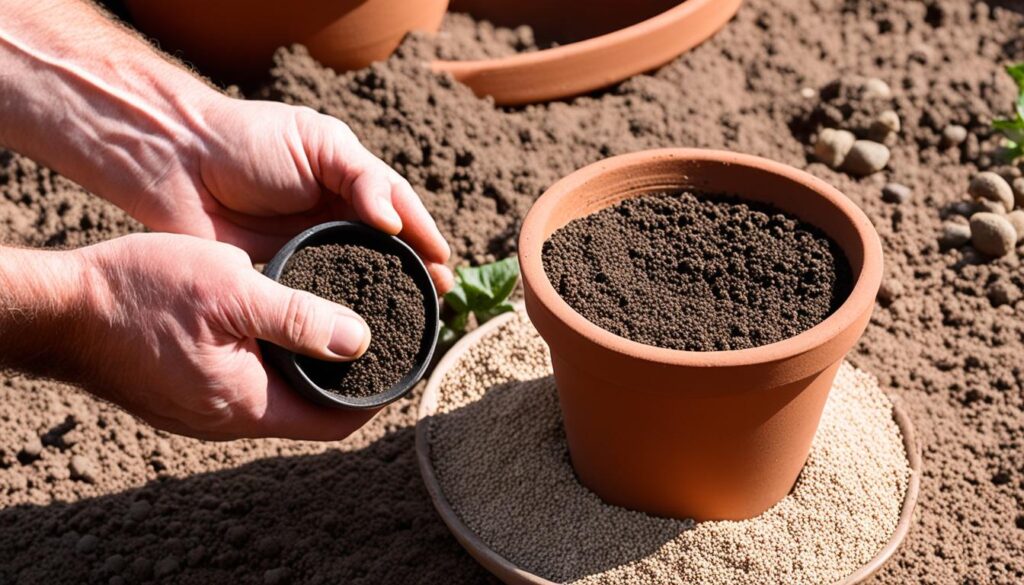
Terracotta pots can be an excellent choice for snake plants as they absorb moisture from the soil, promoting faster drying. This helps prevent overwatering and ensures the soil remains well-drained, benefiting the overall health of your plant.
3. Well-Draining Soil is Essential
Selecting the right soil is crucial in maintaining the proper moisture levels for your snake plant. Choose a well-draining soil mix specifically formulated for succulents or cacti, such as cactus soil. These soil blends allow excess water to drain easily, preventing the risk of overwatering and root rot.
4. Improve Drainage with Stones
You can enhance the drainage capability of your pot by placing a layer of small stones at the bottom before adding the soil. The stones create a barrier that prevents the soil from clogging the drainage holes and helps excess water flow through more efficiently.
By selecting a pot with good drainage and using well-draining soil, you can create an environment that promotes healthy growth and reduces the risk of overwatering for your snake plant.
Environmental Factors
When it comes to caring for your snake plant, understanding the environmental factors that can affect its watering needs is crucial. Factors such as temperature, humidity, and lighting play a significant role in determining how often you should water your snake plant.
Temperature
The temperature of your surroundings can impact the rate at which your snake plant uses water. In higher temperatures, the plant’s water needs increase, and you may need to water it more frequently. On the other hand, in cooler temperatures, the plant’s water requirements decrease, and you can reduce the frequency of watering.
Humidity
The humidity levels in the air also affect the amount of water your snake plant needs. Higher humidity levels result in slower evaporation, which means the plant may require less frequent watering. In contrast, lower humidity levels can cause the soil to dry out more quickly, necessitating more frequent watering.
Lighting
Proper lighting is essential for snake plants, as it affects their overall health and water requirements. While snake plants can tolerate a range of lighting conditions, it’s best to provide them with moderate, non-direct sunlight. Excessive sunlight can lead to faster water evaporation and may require more frequent watering.
Take these environmental factors into consideration when determining the optimal watering schedule for your snake plant. By adapting to the specific conditions of your plant’s environment, you can ensure that it receives the right amount of water to thrive.
FAQs about Watering Snake Plants
As you care for your snake plant, you may have some questions about watering. Here are some frequently asked questions to help you navigate the ins and outs of snake plant care.
1. How often should I water my snake plant?
The watering frequency for snake plants can vary depending on different factors. As a general rule, you should water your snake plant once the soil has completely dried out. During the warmer months of spring and summer, when there’s increased light and temperature, you may need to water your snake plant every one to two weeks. In contrast, during the cooler months of fall and winter, you can reduce watering to every two to three weeks or even less.
2. Should I mist my snake plant?
While misting can provide additional humidity, it’s generally not necessary for snake plants. Snake plants are native to arid regions and are adapted to low humidity levels. Misting can actually increase the risk of overwatering, which can lead to root rot. Focus on watering the soil directly and avoiding getting water on the leaves.
3. Can I use tap water to water my snake plant?
Tap water can be used to water your snake plant, but it’s recommended to use purified water if possible. Tap water often contains chlorine and other minerals that can accumulate in the soil over time. Using purified water helps reduce the risk of harmful mineral buildup and ensures the health of your snake plant.
4. How do I know if I'm overwatering or underwatering my snake plant?
Overwatering and underwatering can both cause issues for your snake plant. Signs of underwatering include yellowing leaves, crispy leaf tips, and dry, compacted soil. On the other hand, signs of overwatering may include yellow leaves, mushy stems, waterlogged soil, and a foul smell. It’s important to monitor your plant and adjust your watering routine accordingly.
5. Can I grow my snake plant in water alone?
Yes, snake plants can be grown in water alone. This method, known as hydroponics, involves rooting the snake plant in water instead of soil. However, it’s important to provide the plant with adequate nutrients to support its growth. You can use a hydroponic fertilizer to supply the necessary nutrients for your water-grown snake plant.
Remember, understanding how often to water your snake plant is crucial for its overall health and well-being. By considering the specific care tips and watering needs for snake plants, you can ensure that your plant thrives and continues to bring beauty to your home.
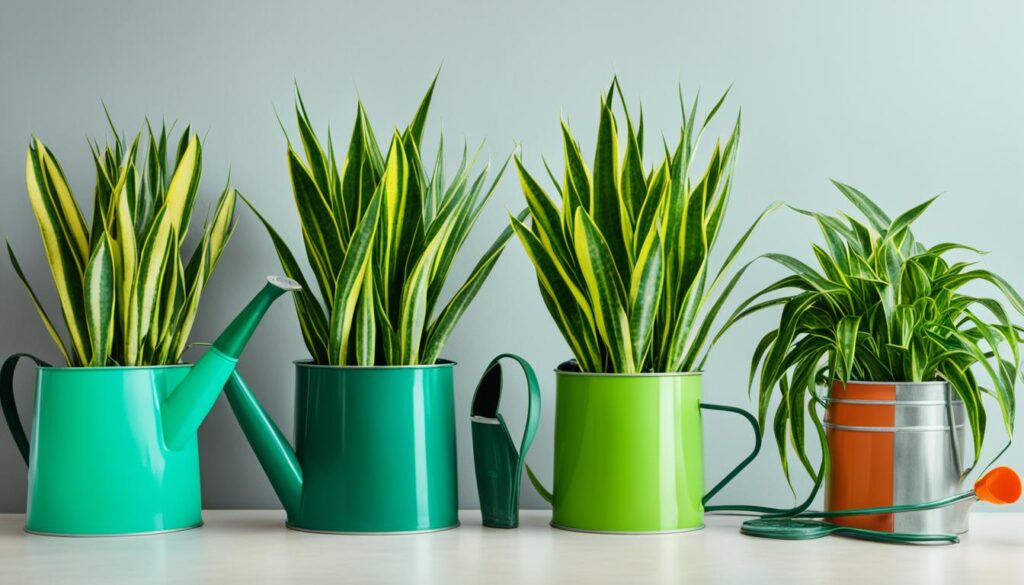
Conclusion
Proper snake plant care, especially when it comes to watering, is crucial for maintaining the health and vibrancy of your plant. By taking into account various factors like light, temperature, humidity, soil type, and potting container, you can establish an optimal watering schedule that caters to your snake plant’s specific needs.
It’s essential to remain vigilant and observe signs of both underwatering and overwatering. Adjust your watering routine accordingly and always remember that it’s better to underwater your snake plant than to overwater it. Giving your plant the care and attention it requires will result in a thriving snake plant that adds beauty and serenity to your home.
Follow these snake plant care tips and maintain an optimal watering schedule to ensure the longevity of your plant. Happy gardening!
FAQ
How often should I water my snake plant?
Snake plants should be watered once their soil has completely dried out. The frequency of watering depends on factors like light, temperature, humidity, soil type, and potting container.
What factors affect the watering schedule for snake plants?
Several factors can influence the watering schedule for snake plants, including light, temperature, humidity levels, soil type, and the type of potting container used.
What is the ideal watering schedule for snake plants?
Snake plants should be watered more frequently during spring and summer months, typically once a week or every two to three weeks. In fall and winter, they can be watered less frequently, usually every two to three weeks or less.
What are the signs of underwatering in snake plants?
Signs of underwatering in snake plants include brown, crispy leaf tips; dying leaves; and hard, compacted soil that is pulling away from the edge of the pot.
What are the signs of overwatering in snake plants?
Signs of overwatering in snake plants include yellow leaves, mushy stems, waterlogged soil, and water buildup in the pot.
What are some watering techniques and tips for snake plants?
Bottom watering, where you soak the pot in water, is a preferred watering method for snake plants. Avoid misting the leaves and use purified water or tap water without chlorine. Snake plants can also be grown in water alone, which requires a different watering approach.
How do I choose the right pot and soil for my snake plant?
Snake plants should be planted in pots with good drainage, such as those with drainage holes. Using well-draining soil like cactus soil can prevent overwatering and root rot. Adding stones at the bottom of the pot can improve drainage.
How do environmental factors affect the watering needs of snake plants?
Higher temperatures and humidity levels require more frequent watering, while lower temperatures and humidity levels require less frequent watering. Moderate, non-direct sunlight is best for snake plants.
What are some frequently asked questions about watering snake plants?
Here are some common questions about watering snake plants:
- Q: How often should I water my snake plant during winter?
- Q: Can I use tap water to water my snake plant?
- Q: Should I mist the leaves of my snake plant?
- Q: Can snake plants be grown in water without soil?
What is the optimal watering schedule for snake plants?
The optimal watering schedule for snake plants depends on various factors, but as a general rule, wait until the soil has completely dried out before watering again. It’s better to underwater than to overwater a snake plant.

